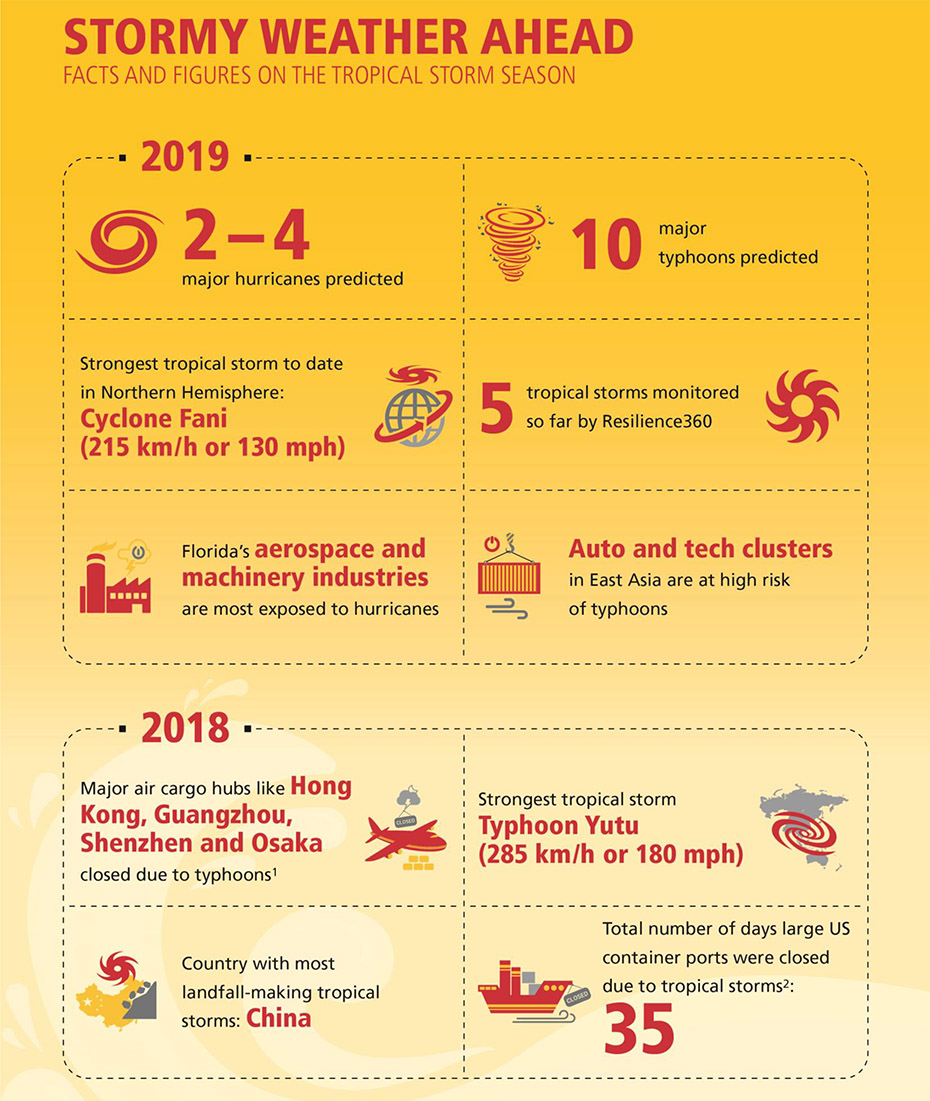As storms continue to strike supply chains across the nation, a new report from DHL has been crafted to help managers mitigate risk and anticipate disruption.
In the run-up to the 2019 hurricane season, Resilience360 has released a report on the potential supply chain impacts of these storms.
The report “Stormy Weather Ahead: A Global Outlook on the 2019 Season” examines the 2018 storm seasons in the Northern Hemisphere and provides an outlook on the 2019 season, including the typical storm paths in each region as well as vulnerable areas and industries.
Also included are recommendations for representatives from procurement, logistics and business continuity management for mitigating the impact of these storms on supply chains.
At the same time, Resilience360 is launching its improved weather shape tracking and alerting capability. The algorithm analyzes the projected path of a hurricane or cyclone and notifies users of possible impacts on their specific supply chains. Using the new capabilities, customers will be able to get better analytics on affected locations and assess what this means for the company's ability to produce and deliver to its end-customers.
“A minor hurricane that affects only a small region can nonetheless prove disastrous if it affects a crucial logistics hub or a critical supplier” explains Tobias Larsson, CEO Resilience360. “Preparedness is key to avoiding costly interruptions. Despite the increasing complexity of supply chains, advanced technologies allow us to map out multi-tiered supply chains, including interdependencies up and down stream. This makes it possible to understand how changes at one node – such as cargo ships stranded at a port – could impact the entire supply chain. When businesses are able to visualize where problems could arise, they can also plan appropriately with back-up suppliers and rerouting when a storm is forecast to hit a key area.”
In an exclusive interview with SCMR, Tobias Larsson, CEO, Resilience360, goes into greater detail on risk.
Improvements in meteorological forecasts now allow scientists to predict a hurricane's path three to five days in advance, affording risk mitigation experts a critical window of time to respond before disruptions occur.
Outlook on 2019 hurricane, cyclone and typhoon seasons
For the 2019 hurricane season, Resilience360 collected forecasts from the leading meteorological agencies to predict the number of tropical storms likely to occur in the Americas, the North Indian Ocean and East Asia. Scientists at the Colorado State University expect five hurricanes, a slightly below-average season in the Americas due to cooler ocean temperatures. However, other forecasters expect a total of seven hurricanes.
The season in this region spans from June through November with a peak in mid-September. In East Asia, the typhoon season began in May and will continue until October. In the absence of a regional outlook, two meteorological services offer localized forecasts.
The Hong Kong observatory expects four to seven tropical cyclones to approach Hong Kong within 500km this year, while the Philippine's National Meteorological and Hydrological Services agency expects two to four in the Philippine area. No official forecasts for the North Indian Ocean region are typically released. The area usually experiences three to four cyclonic storms per year within a season running between April and December with two peaks in May and November.

Areas and industries at risk
In the Americas, aerospace, petrochemical, automotive and pharmaceutical industries tend to lie in risk-prone areas in Florida and along the Gulf and East Coast as well as in Puerto Rico. Typhoon season in East Asia could threaten manufacturing hubs in China and Japan, automotive clusters further inland in China and electronics suppliers in southwestern Japan. For the North Indian Ocean, more than 80 percent of cyclones affect the eastern coast of India, affecting the petrochemical, pharmaceutical, automotive and other heavy industries.
Mitigating supply chain disruptions
Despite the difficulty of predicting exactly when and where storms will hit, businesses can take short- and long-term precautionary measures to mitigate the impact. In the short-term, companies should create continuity plans, stock up on essential materials, and ensure methods of communication are available in the case of power outages. In the longer term, visibility tools, diversifying the company's network, and establishing long-term partnerships with logistics suppliers can strongly influence how seriously a supply chain is affected by a hurricane. Resilience360 experts use advanced mapping techniques, near real-time information from meteorological organizations, and the visibility and risk management to identify potential storms and disruptions for specific customer supply chains.
The full report “Stormy Weather Ahead: A Global Outlook on the 2019 Season” can be downloaded at http://www.resilience360.dhl.com.
SC
MR


Latest Supply Chain News
Latest Resources

 Explore
Explore
Business Management News
- Supply chain salaries top $100K for first time
- Supply chain’s rise in prominence brings regulatory compliance into focus
- Inflation continues to have a wide-ranging impact on supply chains
- Strategic cost savings differ from cutting costs
- Planning fatigue may be settling in
- Inflation, economic worries among top supply chain concerns for SMBs
- More Business Management
Latest Business Management Resources

Subscribe

Supply Chain Management Review delivers the best industry content.

Editors’ Picks





